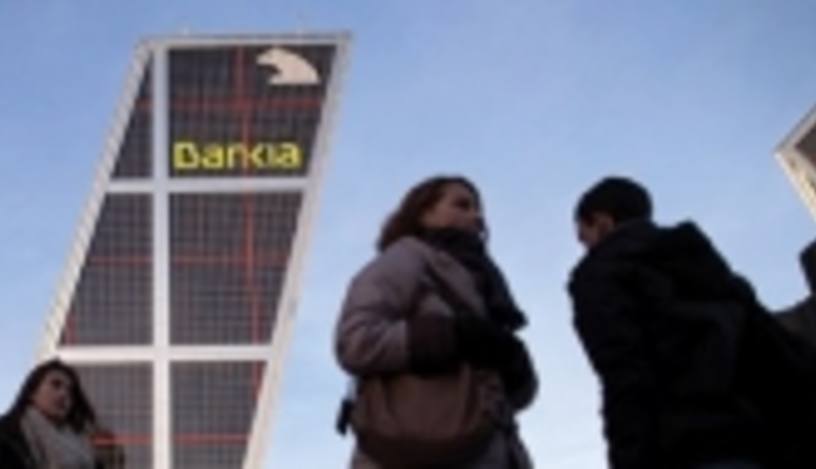One might not expect to find a relaxed and smiling chairman behind his desk at Bankia, the biggest financial casualty of Spain’s double-dip recession, but José Ignacio Goirigolzarri may have good cause to feel confident about the progress achieved since May 2012. That was when the former CEO of BBVA, Spain’s second largest bank, took the reins at Bankia, with the brief of turning around an institution that was struggling for its very survival.
Editor's choice
Bankia’s problems arose over its large exposure to the property sector, the collapse of which had sent the Spanish economy into freefall. In December 2010, seven savings banks, known as cajas, created a conglomerate called Banco Financiero de Ahorros (BFA), which was in effect a mutual support mechanism set up to deal with the group’s urgent capital needs. The major shareholder was Caja Madrid, Spain’s second largest caja, which held a 50% interest. In May 2011, BFA was restructured, with the group’s banking assets transferred to Bankia.
By 2012, Bankia was the third largest lender in Spain, but it was also the largest holder of property assets, with a portfolio totalling €38bn – and this is what eventually signalled what sounded like the bank’s death knell. In 2008, the Spanish property bubble burst and the market started to drop fast. House prices decreased dramatically by 8% in that year alone, while by 2013 they had crashed by 37%.
Recovery mode
New provisioning requirements by the Bank of Spain led to a major capital shortfall and that was when international management consultancy Oliver Wyman was called in to perform a stress test on Spanish banks. In the case of Bankia, the result was that the group’s capital requirements were estimated at €13.2bn to €24.7bn. BFA asked the government for €19bn and was given an €18bn injection. The rest was covered by transferring the group’s bad assets to Sareb, a company responsible for managing assets transferred by the four nationalised Spanish financial institutions: BFA-Bankia, Catalunya Banc, NGC Banco-Banco Gallego and Banco de Valencia.
At that point, in June 2012, Spanish prime minister Mariano Rajoy’s centre-right government decided to take up an offer by EU finance ministers to provide a €100bn bail-out for its ailing banks. In the end, only about €40bn was used, half of which went to Bankia.
The call for EU emergency funding came one month after Mr Goirigolzarri was appointed chairman of Bankia. “When I accepted the job we put in place a strategic plan for the period 2012 to 2017,” says Mr Goirigolzarri. “This was approved by the European Commission, the Bank of Spain and the government’s bank restructuring programme FROB, the Fund for Orderly Bank Restructuring.”
The details of this drastic restructuring called for a cut in Bankia staff numbers by more than 6000, the closure of more than 1000 branches, a pull out of the property lending market and the shedding of some €50bn of assets, as the group refocused its operations on retail banking.
In 2013, Bankia's non-performing loan (NPL) portfolio was reduced by €1.2bn to €18.6bn. For accounting purposes, the figure was actually €20bn, in compliance with a change in the Bank of Spain’s classification of refinanced loans. This was cut by another €800m in the first quarter of 2014 to €19.2bn, of which some €300m was achieved through the disposal of doubtful loan portfolios. By the end of March this year, Bankia had divested €36.2bn in non-core assets, of which €22.3bn was transferred to Sareb.
“In the third quarter of 2013 and following on into the first quarter of this year, we have observed a deceleration in the formation of NPLs [at Bankia],” says Cristina Torrella, a senior director at Fitch Ratings. “This may be a sign that Bankia’s asset quality [has] reached a turning point, but we still have to see if the trend is sustainable. Cost synergies are still not fully reflected in the profit-and-loss account. We have seen an improvement in the cost of deposits, and this should serve as a boost to profitability. But there is uncertainty over when lending volumes will pick up and margin pressure is likely to stay on the asset side.”
Not all bad news
María Cabanyes, an analyst at Moody’s, is more upbeat about the bank's prospects. "One positive fact about Bankia is that, unlike other Spanish banks, the level of NPLs is gradually coming down, accounting for 14.28% of gross loans at end of the first quarter of 2014, thus reducing its distance to the sector average,” she says. “It has been a gradual process and is likely to continue at this pace barring any dramatic move, such as taking a more aggressive approach on write-offs or the selling off of problem portfolios."
Elena Iparraguirre, a banking analyst at Standard & Poor’s, broadly shares Mr Goirigolzarri’s confidence that Bankia’s restructuring programme is on track. “The bank has achieved much and is complying with its restructuring requirements ahead of schedule,” she says. “It was a difficult task, among others reasons, because Bankia was a merger of several savings banks, each with a different culture and often with the active involvement of public authorities. There were many items on our surveillance agenda until recently, but we are now more comfortable that the restructuring is going as planned. We feel confident Bankia is on the path to becoming a stronger institution.”
Mr Goirigolzarri says he is particularly impressed with the speed with which his strategic plan is achieving its targets. “Cutting our branch network by one-third and the reduction in our workforce was by any measure a bold move and not without its risks,” he says. “We had three years in which to accomplish these objectives and we did it in nine months. Despite having to work with a smaller network, by the end of last year we were offering 23% more products through our branches than in December 2012.
"Logically, this achievement was reflected in our results and in the first quarter of this year we were able to announce a net profit of €250m, which is right on target with our restructuring programme. This means that FROB can begin the process of offering 7.5% of Bankia to the private sector.”
Mr Goirigolzarri stated at the bank’s most recent shareholders’ annual meeting in March 2014 that Bankia aimed to pay out dividends in 2015, which would be key to returning money to the state after its bail-out of the bank. This, he said, would show “the board's commitment to working very hard this year so that, in 2015, we can present to the shareholder meeting the option of paying out dividends”. Under the terms of its government bail-out, Bankia is restricted from paying dividends until 2015.
Mixed feelings
Bankia has been signing up new customers at the rate of 12,000 to 13,000 a month, though Mr Goirigolzarri considers this insufficient. His target is 20,000 new customers a month, which should be achievable with Bankia’s strengthened franchise. “Bankia’s image today is totally different from how the bank was perceived two years ago,” he says. “Our new branch network is in place and people are fully focused on the business.”
Fitch Ratings' Ms Torrella says that the agency’s decision to upgrade Bankia’s viability rating, which is a reflection of its standalone credit profile, by two notches to BB- from B, reflects the success of the bank’s restructuring process in de-risking and downsizing in terms of the number of branches and staff. “They are now largely ahead of target,” she says. “This has enabled Bankia to improve its capital level as well as its funding and liquidity position. However, the bank is still facing challenges in the improvement of its asset quality and profitability.”
Mr Goirigolzarri says he is confident Bankia will meet its objective of boosting its return on equity, a key measure of profitability, to 10% by 2015. It stood at 7% in the first quarter of this year, up from 5.6% at the end of 2013. He is also satisfied with the market’s perception of the restructured Bankia, as reflected in the success of senior and subordinated debt issues this year, both of which were oversubscribed. “This is proof that the market takes a positive view of the progress we have achieved,” he says.
Ms Cabanyes says: "The fact that Bankia was able to tap the market with success at the beginning of the year, registering strong demand for the €1bn senior debt, shows that, from an investor perspective, confidence has been restored."
S&P’s Ms Iparraguirre points out that the bank still faces a number of challenges, such as improving the quality of its profits, reducing its reliance on European Central Bank funding and transforming its profits-and-loss statement. “We are seeing good results but this is still largely due to non-recurrent gains,” she says. “Bankia is heading in the right direction but this process will not be completed overnight. One big issue is the transformation of its credit risk profile to ensure that when the credit cycle changes [it does] not fall into high-risk lending practices.”
Mr Goirigolzarri acknowledges this is a key issue, but says it has been dealt with through the restructuring programme. The bank has overhauled its lending policies to ensure a tighter focus on control, scoring and recovery. “We have done away with the third-party lenders which were used in the past to grant loans, such as car dealers and shops,” he says. “Loans are now dealt with exclusively through our branch network. This began to bear fruit at the end of 2013, when we noted a sharp increase in our lending market share.”
One of the biggest surprises in the implementation of the restructuring programme, says Mr Goirigolzarri, was the fact that Bankia managed to retain its market share. “We expected to see a sharp fall, but in 2013 what we witnessed was significant growth in consumer credit and loans to small and medium-sized enterprises [SMEs],” he says. “From December 2013 onwards, we have been growing our market share in deposits and funds, and at the same time we are stabilising the business to achieve an increase in profitability.” He puts this down to customer loyalty, on the one hand, and on the other the lifting of uncertainty once the staff were made aware of the bank’s restructuring objectives.
Back in the game?
Fitch Ratings’ Ms Torrella believes it is too early to say if Bankia will emerge as a strong competitor to the likes of Santander, BBVA and CaixaBank. “The bank is facing challenges to strengthen its franchise, particularly in growing SME lending,” she says.
This is one of Mr Goirigolzarri’s top priorities and to this end Bankia has restructured its network to make SMEs a strategic priority. “This is a real challenge and we have defined our business model to deal with this customer segment,” he says. “We are repositioning our SME franchise for the next two to five years, since this is not a challenge that can be met overnight.”
The market is keeping a close eye on Bankia’s market position. Ms Iparraguirre is sceptical about Bankia posing a major challenge to its major competitors in the short term. “At present, we do not see Bankia growing its market share significantly, after having gone through a process of deleveraging its assets and cutting branches,” she says. “In common with most other Spanish banks, Bankia is more likely to stabilise its market share. This could change in two or three years’ time.”
Ms Cabanyes says there is still need for more improvement in the bank’s financial fundamentals before it can become a strong competitor for CaixaBank and other peers.
Mr Goirigolzarri, on the other hand, believes Bankia is already posing a challenge to other Spanish banks in the market. “It has to be remembered that we are operating with restrictions,” he says. “For instance, the EU has determined that we cannot lend to property developers until 2017. Nonetheless, by the end of this year we expect our efficiency ratios to rank among the best in the market. People now acknowledge Bankia as a force to reckon with.”












